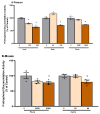Investigating the Contribution of Major Drug-Metabolising Enzymes to Possum-Specific Fertility Control
- PMID: 37298375
- PMCID: PMC10253456
- DOI: 10.3390/ijms24119424
Investigating the Contribution of Major Drug-Metabolising Enzymes to Possum-Specific Fertility Control
Abstract
The potential to improve the effectiveness and efficiency of potential oestrogen-based oral contraceptives (fertility control) for possums was investigated by comparing the inhibitory potential of hepatic CYP3A and UGT2B catalytic activity using a selected compound library (CYP450 inhibitor-based compounds) in possums to that of three other species (mouse, avian, and human). The results showed higher CYP3A protein levels in possum liver microsomes compared to other test species (up to a 4-fold difference). Moreover, possum liver microsomes had significantly higher basal p-nitrophenol glucuronidation activity than other test species (up to an 8-fold difference). However, no CYP450 inhibitor-based compounds significantly decreased the catalytic activity of possum CYP3A and UGT2B below the estimated IC50 and 2-fold IC50 values and were therefore not considered to be potent inhibitors of these enzymes. However, compounds such as isosilybin (65%), ketoconazole (72%), and fluconazole (74%) showed reduced UGT2B glucuronidation activity in possums, mainly at 2-fold IC50 values compared to the control (p < 0.05). Given the structural features of these compounds, these results could provide opportunities for future compound screening. More importantly, however, this study provided preliminary evidence that the basal activity and protein content of two major drug-metabolising enzymes differ in possums compared to other test species, suggesting that this could be further exploited to reach the ultimate goal: a potential target-specific fertility control for possums in New Zealand.
Keywords: Trichosurus vulpecula; brushtail possum; drug-metabolising enzymes (CYP3A and UGT2B); fertility control.
Conflict of interest statement
The authors have no conflict of interest.
Figures






Similar articles
-
In Vitro Hepatic Assessment of Cineole and Its Derivatives in Common Brushtail Possums (Trichosurus vulpecula) and Rodents.Biology (Basel). 2021 Dec 15;10(12):1326. doi: 10.3390/biology10121326. Biology (Basel). 2021. PMID: 34943241 Free PMC article.
-
Inhibition of the microsomal metabolism of 1,8-cineole in the common brushtail possum (Trichosurus vulpecula) by terpenes and other chemicals.Xenobiotica. 2002 Dec;32(12):1109-26. doi: 10.1080/0049825021000022294. Xenobiotica. 2002. PMID: 12593759
-
Tissue distribution of cytochrome P450 3A (CYP3A) in brushtail possums (Trichosurus vulpecula) exposed to Eucalyptus terpenes.Comp Biochem Physiol C Toxicol Pharmacol. 2007 Mar;145(2):194-201. doi: 10.1016/j.cbpc.2006.11.016. Epub 2007 Jan 10. Comp Biochem Physiol C Toxicol Pharmacol. 2007. PMID: 17292676
-
Managing and eradicating wildlife tuberculosis in New Zealand.N Z Vet J. 2015 Jun;63 Suppl 1(sup1):77-88. doi: 10.1080/00480169.2014.981315. Epub 2015 Mar 12. N Z Vet J. 2015. PMID: 25582863 Free PMC article. Review.
-
Possum biocontrol: prospects for fertility regulation.Reprod Fertil Dev. 1996;8(4):655-60. doi: 10.1071/rd9960655. Reprod Fertil Dev. 1996. PMID: 8870087 Review.
References
-
- Environmental Risk Management Authority . Environmental Risk Management Authority Decision. Environmental Risk Management Authority; Wellington, New Zealand: 2008.
-
- Nugent G., Sweetapple P., Coleman J., Suisted P. Possum feeding patterns: Dietary tactics of a reluctant folivore. In: Montague T.L., editor. The Brushtail Possum: Biology, Impact Management of an Introduced Marsupial. Manaaki Whenua Press; Lincoln, New Zealand: 2000. pp. 10–23.
-
- Coleman J., Caley P. Possums as a Reservoir of Bovine Tb. In: Montague T.L., editor. The Brushtail Possum-Biology, Impact and Management of an Introduced Marsupial. Manaaki Whenua Press; Lincoln, New Zealand: 2000. pp. 92–104.
MeSH terms
Substances
Grants and funding
LinkOut - more resources
Full Text Sources

